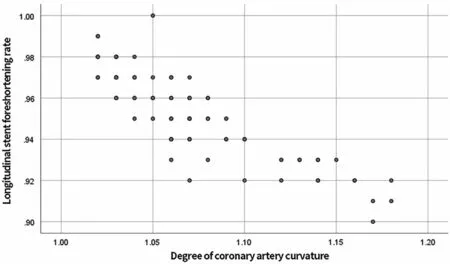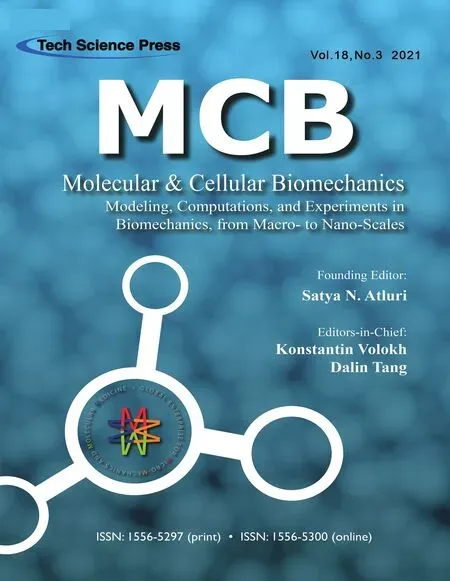Impact of Coronary Artery Curvature on the Longitudinal Stent Foreshortening:Real-World Observations
2021-08-25YangLiRunxinFangRenyunWangQimingDaiZhiyongLiandGenshanMa
Yang Li,Runxin Fang,Renyun Wang,Qiming Dai,Zhiyong Li and Genshan Ma
1Department of Cardiology,Zhongda Hospital,School of Medicine,Southeast University,Nanjing,210009,China
2School of Biological Science and Medical Engineering,Southeast University,Nanjing,210096,China
ABSTRACT Longitudinal stent foreshortening is a known phenomenon,however,the impact of coronary artery curvature on longitudinal stent foreshortening remains unclear.The aim of this study is to determine the impact of coronary artery curvature on the longitudinal stent foreshortening in the real-world scenarios.A total of 86 consecutive patients underwent coronary stent implantation were included in the present study.The degree of coronary artery curvature was defined as the length of the coronary artery curvature divided by the straight length.Longitudinal stent foreshortening was defined as the stent length after implantation divided by the stent length before implantation.The mean longitudinal foreshortening rate of coronary stents was about 94% in curved coronary arteries.Longitudinal stent foreshortening rate was positively correlated with the degree of coronary artery curvature(r=–0.86,P <0.01).Coronary artery curvature is associated with significant longitudinal foreshortening of coronary stents,thus longitudinal foreshortening should be considered on deciding the stent length in curved coronary artery and a longer stent is usually needed in curved coronary artery.
KEYWORDS Stent foreshortening;coronary artery curvature;coronary stent
1 Introduction
Coronary artery stents are widely used in interventional treatment of coronary heart disease[1–3],the length of the stent should be as long as possible to cover the lesion with stenosis more than 30%[4].Coronary stent foreshortening is one of the biomechanical stent characteristics,bench test showed that foreshortening was low and usually ranged from −0.34% to 1.29%[5].Coronary artery tortuosity increases the difficulty of stent implantation[6],coronary artery anatomy might have potential impact on stent shape,including foreshortening after implantation.The aim of the present study is to evaluate the impact of coronary artery curvature on the longitudinal stent foreshortening in the realword scenarios.
2 Methods
2.1 Patient Population
A total of 86 consecutive patients underwent coronary stent implantation in our department from January 2020 to December 2020 were included in the present study.The study was approved by ethic committee of Zhongda Hospital,Southeast University.All enrolled patients signed informed consent.
2.2 Coronary Angiography
Coronary artery curvature and longitudinal stent foreshortening was evaluated on special angulations,LAD was assessed in right anterior oblique with cranial angulations and LCX in right anterior oblique with caudal angulations,while RCA in left anterior oblique.Quantitative coronary angiography was used to measure the length of the coronary artery and coronary stent.The degree of coronary artery curvature was defined as the length of the coronary artery curvature divided by the straight length(Fig.1).Longitudinal stent foreshortening was defined as the stent length after implantation divided by the stent length before implantation.

Figure 1:The definition of the degree of coronary artery curvature is L1/L2.L1:the length of the coronary artery curvature L2:the straight length
2.3 Statistical Analysis
The data were analyzed using SPSS(IBM,Version 26).Continuous variables were expressed as mean±standard deviation.Correlation analysis was performed to determine the association between coronary artery curvature and longitudinal stent foreshortening.Pvalues <0.05 were considered significant.
3 Result
A total of 86 implanted stents were selected.The diameter of the implanted coronary stent was 2.5–3.5 mm and the length was 23–36 mm.The mean degree of coronary artery curvature was 1.06 ± 0.04(range from 1.02–1.18),while mean longitudinal stent foreshortening rate was 0.94 ± 0.02(range from 0.90–1.0).Longitudinal stent foreshortening rate was positively correlated with the degree of coronary artery curvature(r=–0.86,P<0.01)(Fig.2).

Figure 2:Scatter plot of the degree of coronary artery curvature and the longitudinal stent foreshortening
4 Discussion
Recoil,foreshortening,and dogboning are important design parameters which influence the crimping and expansion characteristics of a stent[7].Foreshortening of the coronary stent was the percentage change in stent length assessed after stent implantation[5].Successful stenting should cover coronary lesion with more than 30% stenosis[8].The longitudinal foreshortening of the stent is directly related to the precise positioning of the stent in the coronary lesion location.Low shortening rate belongs to the essential feature of coronary stents.The influence of coronary artery curvature on the stent foreshortening in the real-world scenarios is still unknown now.
Present study found that the stent foreshortening rate could increase to about 90% in case of severe curvature.Bench test showed that the foreshortening of stents tested is quiet small and less than 1.29%[5],but in the present study we found that the foreshortening of stents were significantly increased,the reason might be considered to be related to the structure of curved blood vessels.A previous case report also demonstrated longitudinal stent foreshortening of a contemporary coronary nitinol stent[9].Foreshortening might be a potential limitation of stent design that may predispose the stented vessel to a higher risk of neointimal hyperplasia[10],but it might also occur in case of coronary artery curvature as shown in this report.The improved mechanical properties,behaviors,and design parameters of stent may reduce the possibility of longitudinal stent foreshortening,and subsequent restenosis risk induced by the foreshortening or the dogboning[11].In case of stent implantation in case of coronary artery curvature,stent with less physical longitudinal stent foreshortening features should be considered and the stent length should be long enough to cover the lesion plus calculated longitudinal stent foreshortening.
Limitation:The length of the stent was measured by quantitative coronary angiography in our study,intravascular ultrasound might be a better choice for more accurate measurement of the stent length.
In conclusion,the curvature of the coronary artery can increase the longitudinal shortening of the coronary stent in real-world scenarios,so the length of the stent selected in the curved coronary artery should be appropriately increased accordingly.
Funding Statement:This research was partially supported by National Natural Science Foundation of China(NSFC)under Grant No.81300159.
Conflicts of Interest:The authors declare that they have no conflicts of interest to report regarding the present study.
杂志排行
Molecular&Cellular Biomechanics的其它文章
- Analysis of the Movement Track of Top Spinning Ball and Biomechanics in the Process of Hitting Tennis Ball
- Surface Topography Assessments of Spine Shape Change within the Day in Healthy Male Adults
- Comparison of Detection and Classification of Hard Exudates Using Artificial Neural System vs. SVM Radial Basis Function in Diabetic Retinopathy
- Study of Hepatocytes Polyploidization Peculiarities in Cholestatic Liver of Adult Rats
